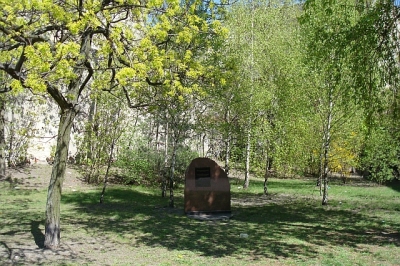
The Old Jewish Cemetery was once located in what is today bordered by Limanowskiego, Bazarowa, Rybna and Zachodnia streets. It was completely destroyed when Zachodnia Street was extended.
This was the first Jewish cemetery in Lodz. It was established in 1811. The Jewish community initially bought a plot of land from Magdalena and Adam Lipinski. Gradually, adjacent land was purchased and the cemetery grounds expanded. In time, the cemetery was enclosed by a low red brick wall and buildings towered over its perimeter. Situated in the old district of the city, it was commonly known as "The Cemetery on Wesola Street" in reference to the small street that led to this Jewish graveyard.
By 1892, more than 13,000 Jews were buried here, among them many distinguished industrialists, social and religious leaders and teachers. For instance, Samuel Zalcman, a yarn wholesaler and owner of tenement buildings between Pomorska and Polnocna streets, was one of the most important figures of 19th-century Jewish Lodz. It was Zalcman who for years fought to abolish the discriminatory laws that required the city's Jews to live in a ghettoized Jewish quarter in the Old Town. Eventually, the Jews won the right to live outside that area. Zalcman, subsequently, built a street between Pomorska and Srednia streets and named it Zalcman Street. Today that street is called Solna Street.
The names of some of the most powerful families that helped build Lodz - the Silbersteins, the Prussaks, the Rosenblatts - colored the headstones in this Jewish cemetery. The grave of Kalman Poznanski, father of Izrael Poznanski, the legendary industrialist that erected the huge factory complex on Ogrodowa Street, is located here.
After 1892, few people were buried in the old cemetery grounds. A new Jewish cemetery on Bracka Street was established and became the main resting place for the city's Jewish residents [see: The Jewish Cemetery].
The funeral house at the Wesola Street cemetery became a hospital for the mentally ill. In 1941, the patients were moved to an undisclosed place outside of the ghetto and in September 1942 the building was officially deemed no longer a hospital. The victims were ultimately deported to the death camp at Chelmno-nad-Nerem and killed. Beginning in 1942, a carpentry department was set up in the building. .
Destruction of the old cemetery began during the Nazi occupation. Some of the headstones were pulled down and used to pave roads. But, for the most part, the cemetery survived the war. It was towards the end of the 1960s the Lodz city authorities decided to further develop Zachodnia Street and, in the process, completely destroyed the Old Jewish Cemetery.
Today buses, cars and trams run over the cemetery grounds. Apartment blocks also dot the land where old Hebrew-engraved headstones once stood. The destruction, it should be noted, was carried out in violation of Polish law. The graves, meanwhile, remained in place. Human bones can be found under the lawn between the residential buildings.
For the longest time, many people in Lodz were unaware that a Jewish cemetery was once located at this site. In April 2004, a commemorative headstone, or matsevah as it is called in Hebrew, was placed in a small square at 11 Rybna St. An inscription in Polish, English, Yiddish and Hebrew is a reminder that the first Jewish cemetery in Lodz once marked the grounds here.
About two months ago, a German medical committee inspected the ghetto hospital located on Wesola Street. Yesterday, two German doctors accompanied by Chairman Rumkowski arrived at the hospital. At present, 60 patients are treated there. The hospital management submitted a list of 12 successfully cured patients to the German doctors. They were examined during the inspection, and five of them were allowed to be released from the hospital [...]. As for the other patients, however, the hospital management was ordered to prepare them to be transported out of the ghetto in two groups. Before leaving the hospital, the patients were injected with tranquilizers. During the day, the families of the patients gathered in front of the hospital, anxious about the unknown fate destined for their relatives. It is worth mentioning that last March the hospital was emptied of the patients in a similar way.
The Chronicle of the Lodz Ghetto, September 1941, Vol. 1, p. 226.
Regarding the space requirements of the wooden products department, resulting from the huge orders received, the Gettoverwaltung orders the requisition of the old cemetery, which abuts the factory premises, for wood depots. The gravestones are to be used for paving the lanes. Considering the fact that the orders cannot be canceled, the Rabbinical Office asked to save as much as possible. In any case, it requested that a detailed plan of the cemetery be made immediately so that the position of the graves can be reconstructed in the future.
The Chronicle of the Lodz Ghetto, June 26, 1942, Vol. 2, p. 89.
The wooden products department has recently developed very fast. At present, the second workshop is organized in the building next door on Wesola Street, where a hospital was formerly located. It is a very large, three-storey building. Apart from this, the old cemetery on Wesola Street is being leveled, and a wood depot is to be located there. The largest order filled by the wooden products department at present includes clogs, playpens for babies, shoemaker's lasts (2 million pieces) and wooden heels; moreover, the Ghetto Board proposed the department produce toys worth 1 million marks in total. The department is currently employing 1,200 workers and operates two shifts.
The Chronicle of the Lodz Ghetto, October 5, 1942, Vol. 2, p. 286.

 Home
Home
